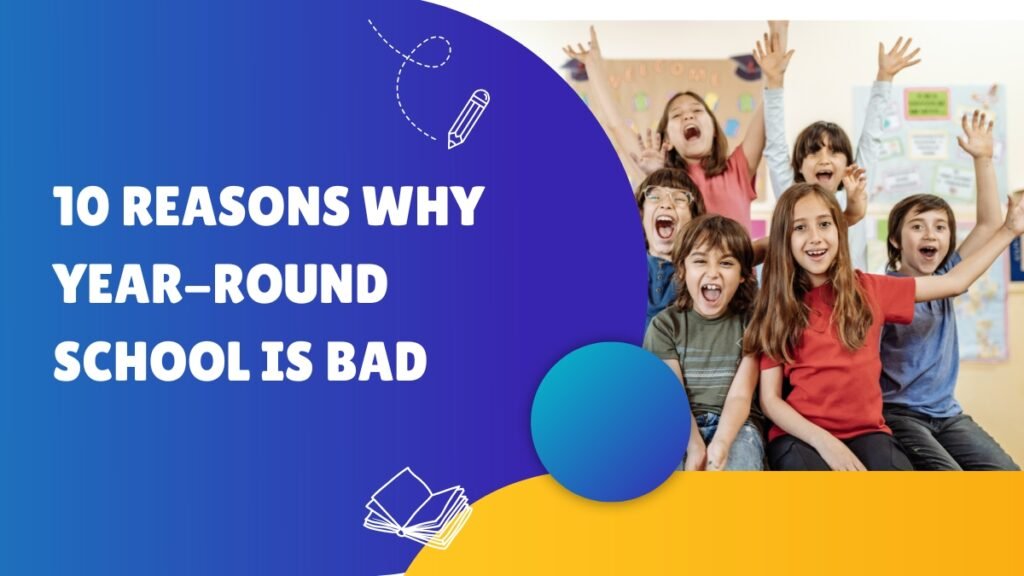Explore 10 reasons why year-round school is bad choice for students and families. Learn about its impact on relaxation, family time, and academic stress.
School’s out for summer! But these days, year-round schooling is becoming more common. While some say it boosts grades and cuts down on forgetting what you learned, others argue it messes with important downtime, family time, and even teacher rest.
Here are 10 reasons why year-round school might not be for everyone. We’ll look at how it could affect students, families, and teachers, highlighting why taking a solid break from school matters. So, before we swap beach days for books all year round, let’s think about the downsides of year-round schooling.
10 Reasons Why Year-Round School Is Bad PDF
Definition of Year-Round School
Year-round school, also called continuous learning or balanced calendar, replaces the long summer break with shorter breaks spread throughout the year. Key features include:
- No Long Summer Break: Instead of 2-3 months off, students get shorter breaks of 2-4 weeks at different times.
- Different Schedules: Schools use either a single-track system (same schedule for everyone) or multi-track system (groups rotate breaks).
- Balanced Breaks: The aim is to evenly spread vacation time to reduce learning loss without increasing the total number of school days.
Year-round school changes how vacation time is scheduled but doesn’t necessarily mean more days of school overall.
Debate on Why Year-Round School Is Bad
The traditional summer break is cherished for relaxation and family time. Year-round schooling aims to boost academics but has drawbacks:
Here’s the information organized into a tabular format:
| Concern | Impact |
|---|---|
| Less Relaxation | Students may burn out without a long break. |
| Fewer Activities | Shorter breaks limit hobbies and camps. |
| Family Time Impact | Breaks scattered year-round disrupt vacations. |
| Teacher Fatigue | Continuous teaching can lead to burnout. |
| Higher Costs | Year-round schedules increase staffing and utility expenses. |
| Climate Challenges | Extreme weather may disrupt schedules. |
| Social Development | Extended breaks foster social skills. |
| Less Flexibility | Harder for families with unique needs or seasonal activities. |
| Mixed Evidence | Academic gains may not outweigh overall well-being concerns. |
| Cultural Disruption | Year-round schooling can alter summer traditions. |
Choosing year-round schooling involves considering these impacts on students, families, and communities.
10 Reasons Why Year-Round School Is Bad
Check out 10 reasons why year-round school is bad:-
1. Student Burnout
Continuous Pressure: Without a long break, students may feel stressed and tired, making it harder to stay focused and motivated in class.
Lack of Time to Relax: Constant schooling can leave students feeling worn out, needing time to recharge their energy and enthusiasm.
2. Limited Enrichment Opportunities
Missing Out on Activities: Summer breaks allow students to explore hobbies, attend camps, and volunteer, which help them grow personally and learn new skills.
Less Time for Creativity: Shorter breaks during year-round schooling mean less time for students to pursue creative interests like art, music, or sports.
3. Family Time Disruption
Less Quality Time: Summer vacations are important for families to bond, travel, and enjoy activities together, which can be harder with year-round schooling.
Difficulty in Planning: Families find it challenging to plan vacations or schedule activities when breaks are shorter and scattered throughout the year.
4. Teacher Fatigue
Continuous Teaching: Teachers may feel tired and less effective without regular breaks to recharge and prepare new lessons.
Need for Rest and Development: Longer breaks allow teachers to attend workshops, rest, and improve their teaching skills, which benefits students.
5. Cost Concerns
More Expenses: Year-round schooling requires extra money for staffing during off-peak times and maintaining buildings throughout the year.
Budget Challenges: Schools must manage finances carefully to cover ongoing costs like utilities and maintenance, which can strain budgets.
6. Climate Challenges
Weather Disruptions: Schools in areas with extreme weather may face closures or changes in schedule, affecting learning and safety.
Safety Precautions: Planning for weather emergencies is crucial to keep students safe and ensure learning continues without interruptions.
7. Social and Emotional Impact
Building Relationships: Longer breaks give students time to make friends and develop social skills outside of school.
Emotional Well-being: Time away from school pressures helps students relax and feel happier, promoting mental health.
8. Lack of Flexibility
Family Needs: Traditional breaks fit better with families’ schedules, like seasonal work or childcare arrangements.
Community Connections: Aligning with community events helps schools and families stay connected, supporting students in their educational journey.
9. Uncertain Academic Benefits
Mixed Results: Research on year-round schooling shows varying effects on student learning and achievement.
Long-term Effects: More studies are needed to understand how year-round schedules impact students over time and if they improve learning outcomes.
10. Disruption of Traditions
Community Events: Summer breaks are often tied to local traditions and celebrations that bring communities together.
Cultural Impact: Changing school schedules can affect community pride and student morale tied to these traditions.
These points provide a clear and engaging look at the potential drawbacks of year-round schooling, showing why it’s important to consider both the benefits and challenges before making a decision.
Why is year-round school bad for mental health?
Check out why year-round school is bad for mental health:-
Increased Stress and Burnout
Constant Pressure: Without a long break, students feel continuous stress and academic pressure, leading to anxiety and reduced motivation.
Tiring Routine: Students can become overwhelmed with constant learning, affecting their mental well-being.
Limited Time for Relaxation and Recharge
Need for Downtime: Experts stress the importance of relaxation for mental health. Summer break allows students crucial time to unwind, pursue hobbies, and recharge.
Less Relaxation: Year-round schooling may cut down on this vital downtime, leaving students less refreshed and more stressed.
Disrupted Sleep Patterns
Sleep Challenges: Year-round schedules with shorter breaks can disrupt students’ sleep routines, which are crucial for mental health.
Impact on Well-being: Poor sleep can worsen stress and anxiety levels, affecting overall mental well-being.
Reduced Opportunities for Social and Emotional Growth
Social Skills: Summer breaks offer chances for students to build friendships and explore interests beyond school.
Limited Development: Year-round schooling might limit these opportunities, affecting students’ social and emotional development.
Impact on Family Dynamics
Changes in Routine: Shorter breaks can disrupt family bonding time traditionally enjoyed during summer vacations.
Family Stress: These changes may strain family relationships and increase stress for both children and parents.
Teacher Stress and Classroom Environment
Teacher Burnout: Continuous teaching without breaks can lead to burnout among educators, impacting classroom dynamics.
Learning Environment: Stressed teachers may struggle to maintain a positive and engaging classroom atmosphere, affecting student well-being indirectly.
Considering these points highlights potential challenges with year-round schooling, especially concerning mental health and overall well-being.
Can year-round school cause burnout?
Yes, it is:-
Student Burnout
Constant Academic Pressure: Year-round schooling means less downtime, leading to chronic stress and reduced motivation.
Limited Time for Recharge: Summer break is crucial for mental rejuvenation and hobbies, which year-round schooling can restrict.
Disrupted Sleep Patterns: Less breaks can disrupt students’ sleep routines, worsening stress and burnout.
Reduced Social and Emotional Development: Year-round schooling limits opportunities for students to develop social skills and independence outside of academics.
Teacher Burnout
Constant Demands: Teachers face heavier workloads and pressures without significant breaks.
Limited Time for Professional Development: Summer break allows for essential training and preparation, which year-round schooling may reduce.
Reduced Personal Renewal: Teachers need time for personal rest and renewal, which year-round schooling may not adequately provide.
Overall Impact
Year-round school can lead to burnout in both students and teachers, affecting motivation, engagement, and overall well-being.
Why is traditional school better than year-round?
Benefits of Traditional Schooling:
For Students
Recharge Time: Long summer breaks allow students to relax and return to school refreshed and focused.
Enrichment Opportunities: Students can explore hobbies, attend camps, and volunteer during summer, fostering diverse skill development.
Social and Emotional Growth: Unstructured summer time supports social skills and independence outside of school.
For Families
Flexibility: Summer breaks help working parents manage childcare and enjoy family vacations.
Stress Relief: Extended breaks reduce stress for students and parents, easing into the school routine.
Considerations
Learning Loss: Long breaks may lead to academic setbacks, though the effectiveness of year-round schooling is debated.
Cost Considerations: Year-round schooling may require extra funding for staff and facilities during non-peak times.
Choosing between traditional and year-round schooling depends on community needs, student well-being, and family preferences. Each approach offers distinct benefits and considerations to weigh.
Conclusion
While year-round schooling aims to boost academic achievement and tackle summer learning loss, the reasons discussed here raise important concerns. Students, families, and teachers may face increased stress and less time for relaxation and personal growth.
Instead of a one-size-fits-all approach, a balanced solution could involve exploring alternative calendars with strategic breaks or integrating enriching summer programs into the traditional schedule. This approach addresses educational needs while preserving the benefits of a refreshing summer break.
Ultimately, the goal is to support academic success while prioritizing the well-being of students, teachers, and families alike.


